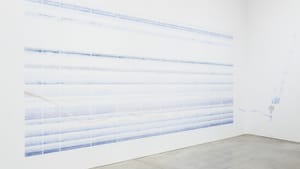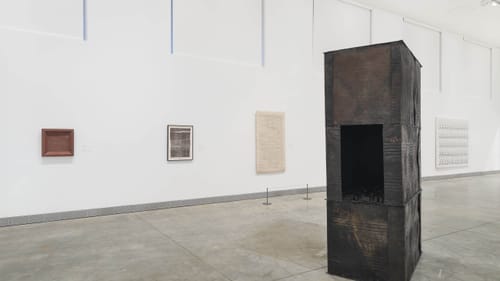Stay in the Loop
BSR publishes on a weekly schedule, with an email newsletter every Wednesday and Thursday morning. There’s no paywall, and subscribing is always free.
Drawing from experience
The Philadelphia Museum of Art presents Fault Lines: Contemporary Abstraction by Artists from South Asia

We define ourselves with lines, drawing boundaries that separate here from there, present from past, us from them. Just so the women featured in Fault Lines: Contemporary Abstraction by Artists from South Asia, now on view at the Philadelphia Museum of Art. With simple lines on canvas and in space, they define their native land, drawing its history, geography, and soul.
Zarina: narrating dislocation
Zarina Hashimi (1937-2020) was shaped by displacement. In 1947, she lost her country and her family when Britain relinquished control of the Indian subcontinent, partitioning the huge territory into Muslim-majority Pakistan and Hindu-majority India, fomenting violence and ethnic tension that has simmered ever since.
When her Muslim family moved to Karachi, Pakistan, Zarina, as she became known professionally, remained in India, having been promised in an arranged marriage to a New Delhi diplomat. Zarina would travel with her husband to world capitals, using the experience to learn printmaking. She eventually separated from her husband, though the couple never divorced. In the 1970s, she became part of New York’s feminist art community and lived in the city for the rest of her life. But it was never home. For Zarina, home was not a place, but a language. As she was quoted in an obituary by Nada Raza of Tate Modern, “Language ties my work together. Urdu is home.”
“Zarina loved words,” Christophe Cherix, MoMA chief curator of drawings and prints wrote in a remembrance. “As she told me …language always came to her first, images only followed. Her mother tongue was Urdu and many of her prints illustrated words that she felt were on the verge of disappearing.”
These Cities Blotted into the Wilderness (Adrienne Rich after Ghalib) (2003) is a catalog of loss. Nine square woodcuts map cities riven by violence. Baghdad and Kabul are depicted from above, while New York is represented by two white voids on a black field. Each canvas bears the location’s name in Urdu. How many squares could be added to this atlas of death?
In addition to works on paper, the exhibit, curated by Amanda Sroka, includes installation and sculptural pieces, such as Zarina’s Hanging in There (2000), which will look familiar to anyone who remembers laundry being hung on lines. A length of linen thread is suspended along the gallery wall. From it curl 90 twists of wire, evenly spaced. They might be clothespins. They might be a string of little ghosts, hanging in there.
Sheela Gowda: medium as message
Over her career, Sheela Gowda (b. 1957) has moved from figurative oils to abstract sculptures, which she creates with substances significant in Indian culture: red kumkuma powder, hair, even cow dung. Gowda repurposes these elements in the service of art, using their essential nature to comment on India’s rapid economic and industrial growth. In a Tate Modern video, she commented, “There is a moment when an idea and a material come together.”
A Blanket and the Sky (2004) is a freestanding work about six feet tall. Consisting of pieced-together tar drums, it depicts the dichotomy of human life. In the lower of two levels is a sign of a hard life: a wool blanket swirled on the ground, occupancy indefinite. Peer into the drum’s pitch-black penthouse for a joyous contrast: punching pinholes in the tin roof, Gowda created a sparkling night sky.

In Untitled (1997), a bright red cord comprised of hundreds of individual threads loops up from the floor to end in a clutch of needles, poised like a patient viper rising to strike. The cord is colored with kumkuma, a powder made from turmeric and lime, which has a range of religious and ceremonial uses. With it, Gowda directs attention to traditional beliefs and women’s social status. A spot of kumkuma on a Hindu woman’s forehead, for instance, signals that she is married. Forehead markings also identify what is believed to be the point of connection between humans and the divine.
Prabhavathi Meppayil: capturing vanishing tradition
Growing up in a family of goldsmiths, Prabhavathi Meppayil (b. 1965) was surrounded by artisans whose tools and craft were quickly disappearing. Her work n/ninety three (2016) illustrates the demise in 16 canvases displaying fine filaments of copper embedded in gesso. Read left to right, the first canvas looks like a page of loose leaf, copper threads substituting for inked lines. Moving right, the lines begin to melt into the white background. By the last they’ve vanished, the copper having oxidized into invisibility.
Meppayil’s work recalls the minimalist practice of Agnes Martin—both women produced meticulous, quiet pieces that are easy to misunderstand, or miss altogether. Ironically, the tendency to overlook understated art is the same tendency that endangers artisanal craft in favor of faster, cheaper, flashier alternatives.
Tanya Goel: coloring with debris
The work of Tanya Goel (b. 1985), the youngest of the four artists on view, distills the quartet’s concern with the existential threat to India posed by uncontrolled growth.
Goel’s muse is the changing skyline of her native New Delhi, but it’s the architectural leftovers, rather than gleaming towers that draw her interest: she makes her colors by crushing the crumbs of building sites. From bits of found limestone, ceramic, glass, charcoal, and concrete, Goel extracts pigments for monumental abstract paintings like Index V (2015/2020), a site-specific piece applied to a gallery wall with a snap-line. See its installation here.
Bands of indigo pigment peak and fall in diluted waves, running horizontally, reminiscent of geologic sediment as it layers time in ancient canyons. A red band, narrower and made from pulverized brick, trails eccentrically through the blue, like a ribbon floating in the ocean. Text explains that the bands correspond to changing sea levels. Given that they’re positioned higher than viewers’ heads, it’s easy to visualize the threat without fully grasping the calculations that produced them.
In notation in x,y,z (2015), Goel created a grid of neutrally colored blocks. They resemble an enormous tile backsplash, but they’re really a hidden map. Beneath each 1”-by-2” square in beige, black, white, and greenish gray, are geographic coordinates marking where in New Delhi Goel found the debris for the color. The website Nature Morte described her approach: “She is interested in the textures of her pigments as well as their colors, which is a direct result of how they reflect light. Her compositions … are mathematical formulas which are established and then violated, resulting in a balance between structure and chaos.”
Considered together, Zarina, Gowda, Meppayil, and Goel refocus the lens of contemporary art to less familiar regions and cultures, directing the gaze to places the artists know intimately and care about deeply. They show India’s similarity to, and its uniqueness from, western experience. By expanding viewers’ vision, these women draw lines that define and permeate boundaries between east and west.
What, When, Where
Fault Lines: Contemporary Abstraction by Artists from South Asia. Through April 10, 2022, at the Philadelphia Museum of Art, 2600 Benjamin Franklin Parkway, Philadelphia. (215) 763-8100 or philamuseum.org.
The Philadelphia Museum of Art follows City of Philadelphia guidance regarding Covid-19 precautions. Proof of vaccination is not required for entry, and mask wearing is optional. Should public safety guidance change, the museum will modify its policies, if necessary.
Accessibility
The Philadelphia Museum of Art provides a variety of accommodations and services to make the buildings accessible to all. Visitors who have questions or need assistance for an upcoming visit should contact the museum at [email protected], or visit the PMA’s accessibility page.
Sign up for our newsletter
All of the week's new articles, all in one place. Sign up for the free weekly BSR newsletters, and don't miss a conversation.
